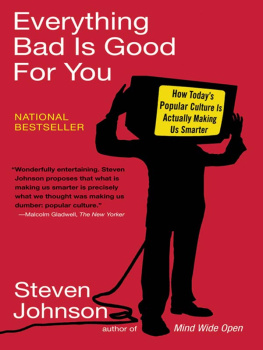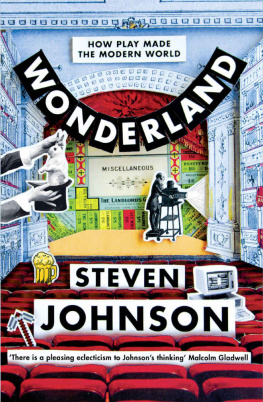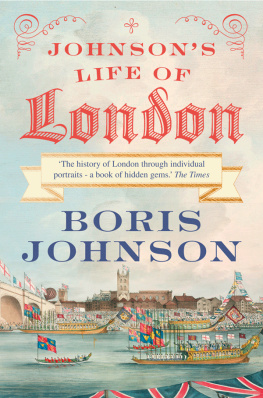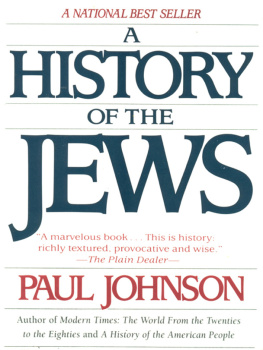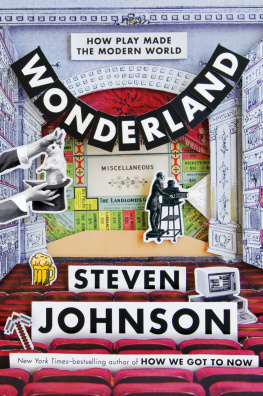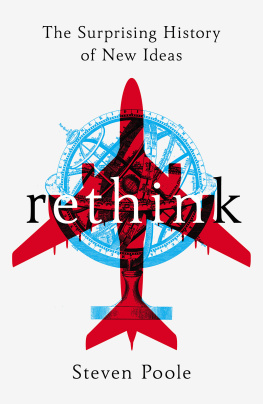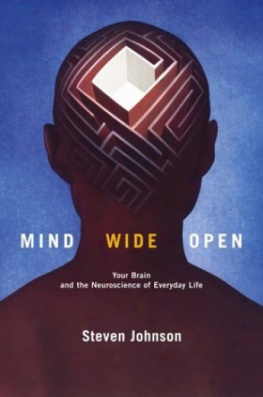ALSO BY STEVEN JOHNSON
Interface Culture:
How New Technology Transforms the Way We Create and Communicate
Emergence:
The Connected Lives of Ants, Brains, Cities, and Software
Mind Wide Open:
Your Brain and the Neuroscience of Everyday Life
Everything Bad Is Good for You:
How Todays Popular Culture Is Actually Making Us Smarter
The Ghost Map:
The Story of Londons Most Terrifying Epidemicand How It Changed Science, Cities, and the Modern World
The Invention of Air:
A Story of Science, Faith, Revolution, and the Birth of America
Where Good Ideas Come From:
The Natural History of Innovation
Future Perfect:
The Case for Progress in a Networked Age

RIVERHEAD BOOKS
Published by the Penguin Group
Penguin Group (USA) LLC
375 Hudson Street
New York, New York 10014

USA Canada UK Ireland Australia New Zealand India South Africa China
penguin.com
A Penguin Random House Company
Copyright 2014 by Steven Johnson and Nutopia Ltd.
Penguin supports copyright. Copyright fuels creativity, encourages diverse voices, promotes free speech, and creates a vibrant culture. Thank you for buying an authorized edition of this book and for complying with copyright laws by not reproducing, scanning, or distributing any part of it in any form without permission. You are supporting writers and allowing Penguin to continue to publish books for every reader.
Library of Congress Cataloging-in-Publication Data
Johnson, Steven, date.
How we got to now : six innovations that made the modern world / Steven Johnson.
p. cm.
Includes bibliographical references and index.
ISBN 978-0-698-15450-6
1. TechnologySocial aspects. 2. InventionsSocial aspects. I. Title.
T14.5.J64 2014 2014018412
338'.064dc23
Version_1
For Jane, who no doubt expected a three-volume treatise on nineteenth-century whaling
Contents
Introduction
Robot Historians and the Hummingbirds Wing
A little more than two decades ago, the Mexican-American artist and philosopher Manuel De Landa published a strange and wonderful book called War in the Age of Intelligent Machines. The book was, technically speaking, a history of military technology, but it had nothing in common with what you might naturally expect from the genre. Instead of heroic accounts of submarine engineering written by some Naval Academy professor, De Landas book wove chaos theory, evolutionary biology, and French post-structuralist philosophy into histories of the conoidal bullet, radar, and other military innovations. I remember reading it as a grad student in my early twenties and thinking that it was one of those books that seemed completely sui generis, as though De Landa had arrived on Earth from some other intellectual planet. It seemed mesmerizing and deeply confusing at the same time.
De Landa began the book with a brilliant interpretative twist. Imagine, he suggested, a work of history written sometime in the future by some form of artificial intelligence, mapping out the history of the preceding millennium. We could imagine, De Landa argued, that such a robot historian would write a different kind of history than would its human counterpart. Events that loom large in human accountsthe European conquest of the Americas, the fall of the Roman Empire, the Magna Cartawould be footnotes from the robots perspective. Other events that seem marginal to traditional historythe toy automatons that pretended to play chess in the eighteenth century, the Jacquard loom that inspired the punch cards of early computingwould be watershed moments to the robot historian, turning points that trace a direct line to the present. While a human historian might try to understand the way people assembled clockworks, motors and other physical contraptions, De Landa explained, a robot historian would likely place a stronger emphasis on the way these machines affected human evolution. The robot would stress the fact that when clockworks once represented the dominant technology on the planet, people imagined the world around them as a similar system of cogs and wheels.
There are no intelligent robots in this book, alas. The innovations here belong to everyday life, not science fiction: lightbulbs, sound recordings, air-conditioning, a glass of clean tap water, a wristwatch, a glass lens. But I have tried to tell the story of these innovations from something like the perspective of De Landas robot historian. If the lightbulb could write a history of the past three hundred years, it too would look very different. We would see how much of our past was bound up in the pursuit of artificial light, how much ingenuity and struggle went into the battle against darkness, and how the inventions we came up with triggered changes that, at first glance, would seem to have nothing to do with lightbulbs.
This is a history worth telling, in part, because it allows us to see a world we generally take for granted with fresh eyes. Most of us in the developed world dont pause to think how amazing it is that we drink water from a tap and never once worry about dying forty-eight hours later from cholera. Thanks to air-conditioning, many of us live comfortably in climates that would have been intolerable just fifty years ago. Our lives are surrounded and supported by a whole class of objects that are enchanted with the ideas and creativity of thousands of people who came before us: inventors and hobbyists and reformers who steadily hacked away at the problem of making artificial light or clean drinking water so that we can enjoy those luxuries today without a second thought, without even thinking of them as luxuries in the first place. As the robot historians would no doubt remind us, we are indebted to those people every bit as much as, if not more than, we are to the kings and conquerors and magnates of traditional history.
But the other reason to write this kind of history is that these innovations have set in motion a much wider array of changes in society than you might reasonably expect. Innovations usually begin life with an attempt to solve a specific problem, but once they get into circulation, they end up triggering other changes that would have been extremely difficult to predict. This is a pattern of change that appears constantly in evolutionary history. Think of the act of pollination: sometime during the Cretaceous age, flowers began to evolve colors and scents that signaled the presence of pollen to insects, who simultaneously evolved complex equipment to extract the pollen and, inadvertently, fertilize other flowers with pollen. Over time, the flowers supplemented the pollen with even more energy-rich nectar to lure the insects into the rituals of pollination. Bees and other insects evolved the sensory tools to see and be drawn to flowers, just as the flowers evolved the properties that attract bees. This is a different kind of survival of the fittest, not the usual zero-sum competitive story that we often hear in watered-down versions of Darwinism, but something more symbiotic: the insects and flowers succeed because they, physically, fit well with each other. (The technical term for this is coevolution.) The importance of this relationship was not lost on Charles Darwin, who followed up the publication of


